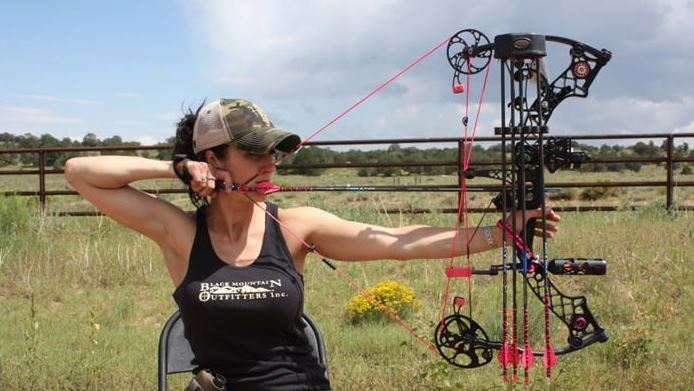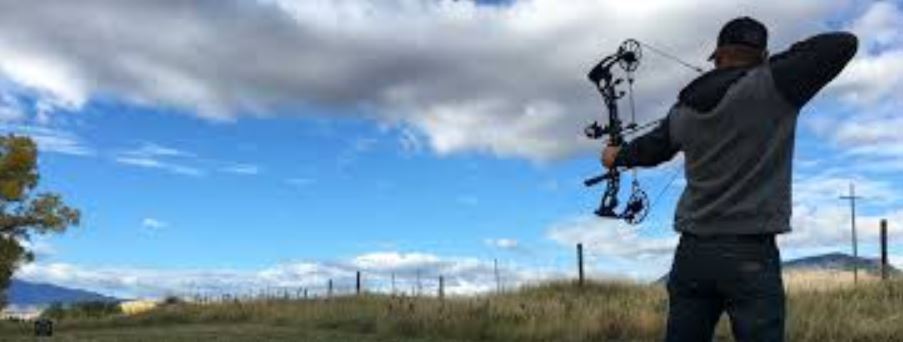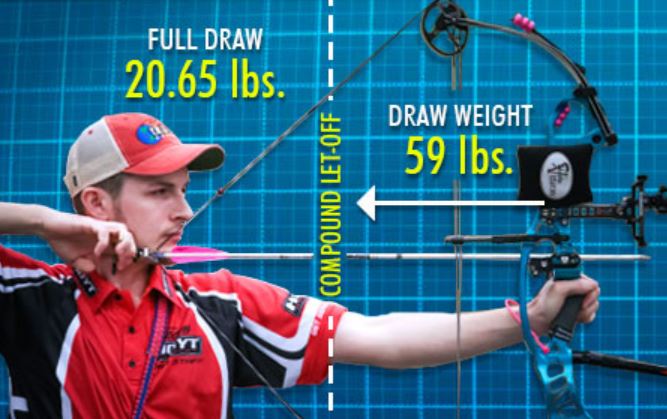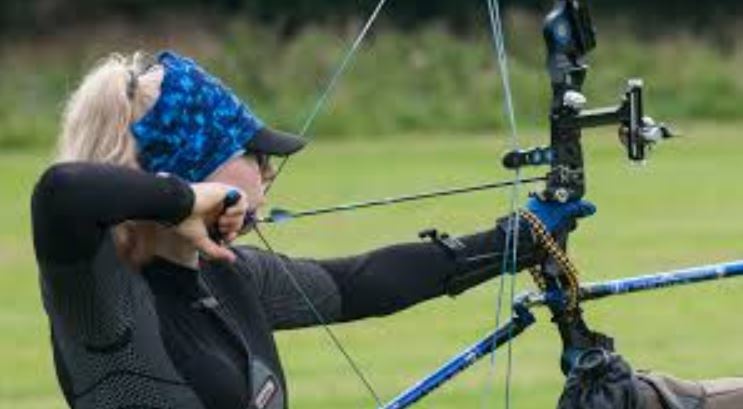Finding the right poundage for your bow can be tricky. The right poundage for you as an individual will depend on several factors such as your skill level and the type of bow you like to shoot. Ultimately you should choose the best poundage that you feel comfortable drawing back repeatedly.
It’s all well and good opting for the heaviest poundage you can draw, but your arms and back will start to feel the strain after you’ve been shooting for more then 20 minutes. Remember that during competitions you’ll be shooting potentially over a 2 or 3 hour period.
So you’ll want to choose a draw weight that’s comfortable for you to pull back repeatedly over long periods of time!

What poundage should my bow be?
The poundage that you feel most comfortable pulling back will differ depending on your physical build and skill as an archer. You will be much better off opting for a slightly lower poundage than going for a bow that’s going to be too heavy for you. PS. Have you ever wanted to try bowfishing?

Children are best off sticking to between 10 and 15 pounds or so depending on their ability. You may want to gradually increase the poundage of the bow as they grow older and their skills develop. Older children or teenagers may feel more comfortable shooting between 15 and 25 pounds.
If you’re a novice archer, we would recommend starting with around 20 pounds. If you feel this is too light, you can upgrade it to 25 or even 30 pounds. It will entirely depend on your particular build and how fit you are. Once you’ve been shooting for a while, you may even wish to try a heavier poundage such as 40 pounds or even 60 pounds.
We would suggest using common sense as to whether you feel comfortable drawing at the heavier weights. There’s no shame in opting for a lighter weight that is more comfortable! The last thing you’ll want to do is choose a draw weight that’s too heavy for you, as you could accidentally dry fire your bow and damage it in the process.
Of course, if you’re a more skilled archer who has been shooting for a while, you will know whether you’re able to draw these heavier weights. It’s also worth bearing in mind that some competitions will insist you shoot at certain draw weights with certain bows, such as compounds at between 40 to 60 pounds.
If you’re in doubt as to which poundage to opt for, you should try shooting with the bow for several ends and see if you feel comfortable at the end of your practice. If your limbs feel tired and you’re struggling to draw back the bow comfortably, you should opt for a lighter bow poundage.
Are heavier bows more accurate?
Not necessarily, no. The accuracy also partially comes down to the archer. You could be capable of pulling back a 60 pound or heavier bow, but that doesn’t mean you’ll have the aiming accuracy to match it.

Often, a lighter bow will allow you to hold the bow at full draw for a longer period of time, meaning you can take your time and aim properly. If you choose a bow that is too heavy for you, you’ll be trying to shoot it as soon as you can. This gives you less time to aim at the target, and your arrows could end up anywhere.
What a heavier bow does give you is more power behind each shot. This is why the heavier compound archers often need to use an arrow puller to remove arrows from the target. Some longbows are capable of achieving much heavier poundage as well, with some bows reaching up to 200 pounds.
Next time you’re in your local archery club, take a look at the other archer’s targets. You’ll notice that barebow and recurve archers at the lighter weights have a decent amount of arrow poking out of the target. The compound archers’ arrows will likely be further into the target.
What is the average draw weight of a bow?
The average draw weight of a bow will differ from bow to bow. Barebows tend to be around 30 pounds or so, depending on the skill and frame of the archer. Recurves could be anywhere between 30 to 45 pounds, with some larger framed archers shooting as much as 60 pounds.

The average draw weight of a compound bow will be between 40 to 60 pounds. These tend to be the poundages typically used in competitions for this bow type. Longbows, horse bows, and flat bows will also have a similar average draw weight of between 30 to 40 pounds.
Again, the average draw weight will also depend on the user in question. Some people feel more comfortable sticking to the 30 pounds that they can draw back comfortably. However, some more experienced archers will also be used to drawing back heavier poundages such as 40 or 60 pound bows.
What is the average draw weight for a woman?
The average draw weight for a woman tends to be around 30 pounds depending on the type of bow. It’s worth remembering that as your back muscles build up over time, you will be able to draw the heavier weights.

So there’s nothing wrong with starting at 20 or 25 and working your way up to 30, 35, or maybe even 40 pounds. It can also be dependent on your personal frame, too. Some people with a larger frame will find it easier to draw the heavier weights.
What is the highest draw weight of a bow?
The highest draw of a bow will depend on the bow in question. Interestingly, some of the heaviest bows are more traditional, such as the longbow or horse bow. In fact, there are some Mongolian horse bows which were known to be up to 166 pounds.

Now that’s a heavy bow! Some longbows can have a draw weight of up to 200 pounds or so, but those aren’t bows that would be used nowadays for regular target practice.
Compound is one of the heaviest bows out of the more popular bows at this moment in time. These can have a poundage of somewhere over 80 pounds. But these heavier bows aren’t allowed to be used in competitions. The maximum weight a compound bow can be for competitions is 60 pounds.
Is it hard to pull back a bow?
This will entirely depend on the poundage of the bow in question. The heavier the poundage, the harder it is to pull back. So a 20 pound bow is going to be easier to pull back than a heavy 60 pound bow. It’s also worth noting that the bow may be heavier or lighter to pull back depending on its type.

Beginners or children tend to be taught to shoot with a jelly bow first before moving on to a barebow, recurve, or compound. These are typically much lighter than traditional bows to get the user used to technique. You can also work your way up through the poundages when your arm and back muscles develop.
A compound bow is always heavier to pull back. These tend to have a heavier draw poundage, but once they’re at full draw, they feel much lighter.
That’s because compound bows are completed with a series of cogs and other instruments known as a cams system to hold the tension in the bow until you’re ready to fire. They allow you to hold it at a lighter weight once at full draw because this means you can aim better using the attached sights, and get better scores.
Compound bows tend to be the bows that you see people shooting at events such as the Olympics. It’s also worth noting that compound bows allow you to adjust the poundage.
How hard is it to pull back a recurve bow?
How hard a recurve bow is to pull back will entirely depend on the poundage of the bow. The heavier the poundage, the trickier it will be to pull back each time. The lighter the poundage, the easier the bow will be to pull back.

This works as a general rule of thumb regardless of the bow type, unless you’re talking about compound bows. As we’ve already discussed, these use a different method and are often more difficult to pull back until you’ve locked them at full draw.
Can you change the draw weight on a recurve?
Yes, you can adjust the draw weight on some recurve bows! You can adjust the draw weight of certain recurve bows by tightening the limbs. However, this only works with bows which have been designed to allow you to adjust their draw weight.

Generally, recurve bows with International Limb Fitting (ILF) limbs and fittings allow you to adjust the draw weight. These are the limbs that you can clip on to your bow rather than secure in place with screws.
In Summary
So in short, you should choose the draw weight that feels most comfortable for you to pull back repeatedly.
There’s nothing wrong with going a little bit under the maximum weight you can draw so that you can shoot more accurately.
Tired arms aren’t going to be able to get accurate scores consistently if you’re too worn out to pull at full draw!

